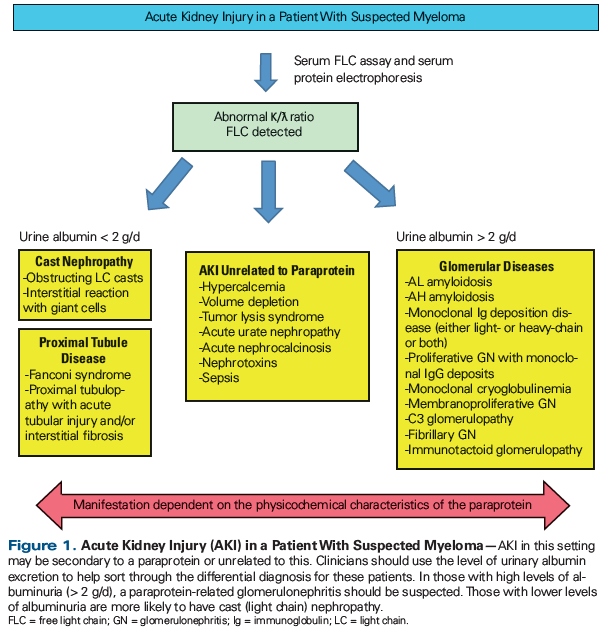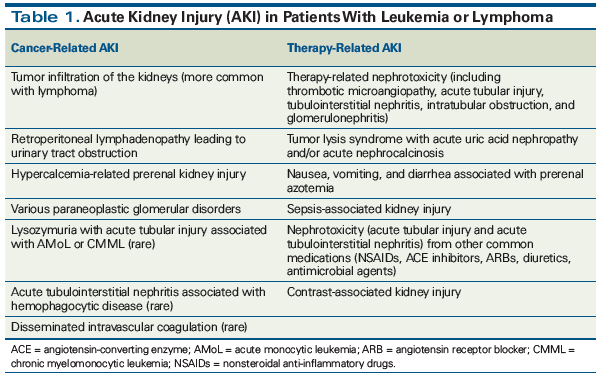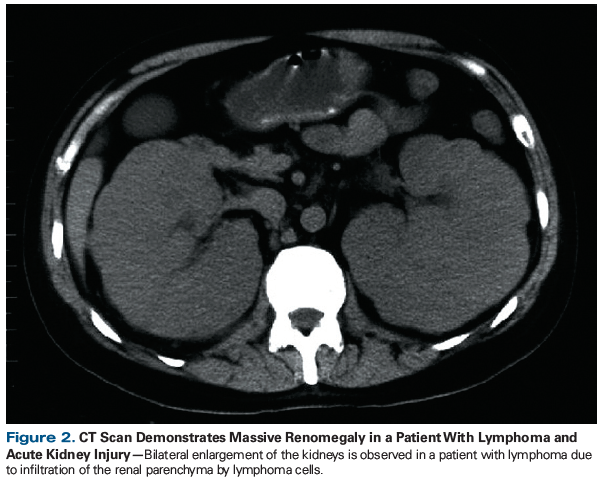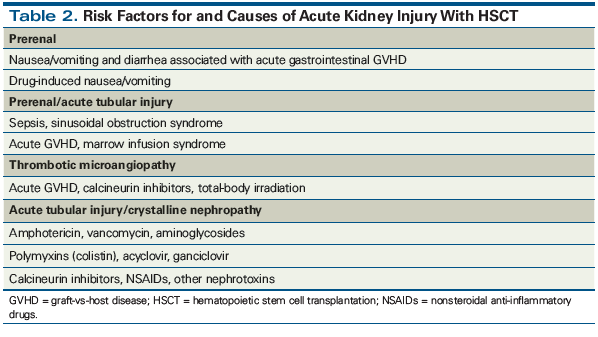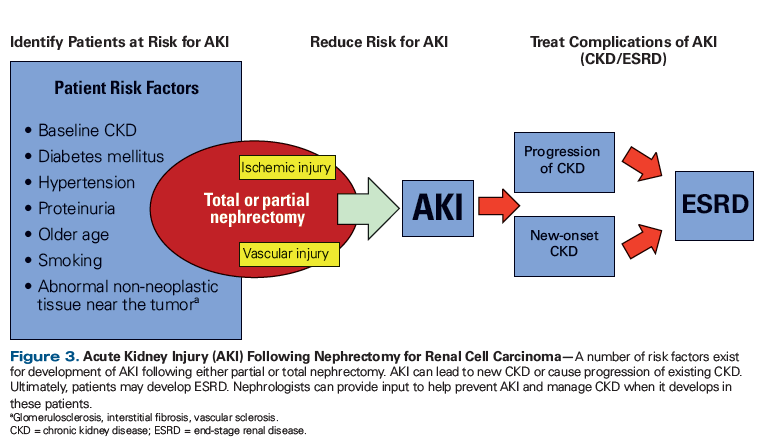Acute kidney injury (AKI) is a common complication in cancer patients and occurs in up to 30% of patients during their disease course. Multiple myeloma, leukemia/lymphoma, renal cell carcinoma, and hematopoietic stem cell transplantation are commonly associated with the development of AKI. Drugs used to treat various malignancies are also a common and notable cause of AKI in this population. Nephrology consultation is important to ensure proper and rapid diagnosis, as well as appropriate therapy and follow-up. In particular, knowledge of the nephrotoxicity of the various anticancer regimens employed is critical. This is a rapidly evolving area that requires continuous updating as new drugs are released into clinical practice and nephrotoxicity is observed.
Epidemiology of AKI in Patients With Cancer
Large population-based studies have supported the conclusion that acute kidney injury (AKI) is common in patients with cancer.[1,2] Depending upon the definition of AKI, the incidence rate varies, but in one study that used a cutoff of > 50% increase in serum creatinine level to define AKI, the rate of AKI was 17.5% within 1 year of cancer diagnosis.[2] Cancers with the highest risk of AKI include renal cell carcinoma (RCC), hepatocellular carcinoma, multiple myeloma, lymphoma, and leukemia.
Common Malignancies and Scenarios Associated With AKI
Multiple myeloma
AKI is common in patients with multiple myeloma (up to 50% will have an elevated serum creatinine level at diagnosis), can be secondary to pathology involving the glomeruli and/or tubules, and can be either directly associated with the production of a paraprotein or unrelated to the paraprotein (Figure 1).[3-5] AKI that is unrelated to paraprotein production is often secondary to volume depletion, hypercalcemia, or tumor lysis syndrome, and typically occurs early in the course of disease for myeloma patients.[6,7] Treatment centers on intravenous hydration and control of electrolyte and metabolic derangements, followed by myeloma-specific therapy. More specific to myeloma is AKI secondary to either a κ or λ paraprotein (Figure 1).[6,7] Depending upon the physicochemical properties of the paraprotein, protein deposition in the glomeruli can lead to glomerulonephritis of various histologic subtypes, typically associated with high-grade albuminuria (> 2 g/d).[8-10] These various paraprotein-related glomerular diseases require kidney biopsy for accurate diagnosis and appropriate therapeutic decision making. Treatment of these forms of glomerulonephritis centers on effective control of myeloma with chemotherapy.
A more common form of AKI associated with myeloma is light chain (LC) cast nephropathy, which refers to tubular injury and intratubular cast formation due to the overproduction and filtration of pathogenic LCs.[11,12] LC nephropathy represents the most common kidney manifestation of myeloma.[5] LCs associate with uromodulin, which is a normal secretory product of the loop of Henle,[13-15] forming intratubular casts that can obstruct urinary flow, as well as incite an inflammatory reaction leading to AKI. Intratubular cast formation is increased by volume depletion, metabolic acidosis, and use of loop diuretics and nonsteroidal anti-inflammatory drugs, as well as by iodinated radiocontrast agents.[16,17]
In addition, LCs are endocytosed by proximal tubular cells, in which they are resistant to protease degradation and can cause proximal tubular injury manifested by Fanconi syndrome with or without AKI.[18,19] Treatment of LC nephropathy is multifaceted and includes cessation of nephrotoxic medications; correction of acid-base and electrolyte disorders, including hypercalcemia; and institution of bortezomib-based antimyeloma therapy in combination with corticosteroids.[20-22] Treatment with bortezomib has the advantage of not requiring dosage adjustments in AKI patients.[23] In patients with a glomerular filtration rate (GFR) < 30 mL/min/1.73 m2, a bortezomib-based triplet therapy regimen resulted in a renal response rate of 72%, with dialysis discontinuation in 57%.[22]
One way to increase the removal of nephrotoxic free LCs is by the addition of plasmapheresis or hemodialysis with a “high-cutoff” membrane, which allows for the removal of larger-molecular-weight proteins (up to 50 kilodaltons). The goal is to rapidly decrease free light chain (FLC) levels, as one study demonstrated that a 60% reduction in FLC levels by day 21 after diagnosis is associated with kidney recovery in 80% of cases.[24] Treatment of LC nephropathy with plasmapheresis remains controversial and is not applicable in patients receiving modern-day bortezomib-based therapy.[25]
Two clinical trials that were recently reported-MYRE and EuLITE-used extracorporeal therapy in addition to bortezomib-based therapy in patients presenting with newly diagnosed myeloma and a need for acute dialysis.[26,27] The MYRE study randomized 98 patients to either standard high-flux hemodialysis (HF-HD) or to high-cutoff hemodialysis (HCO-HD). There was no difference in the primary endpoint of dialysis independence at 3 months between the HF-HD and HCO-HD groups (33% vs 43%, respectively; P = .31). At 6 months, more patients in the HCO-HD arm than the control group were independent of dialysis (60% vs 38%, respectively; P = .03). However, the difference at 6 months was tempered by concern that the renal response to bortezomib in the HF-HD group was less than had been seen in other studies, suggesting that this population may have been atypical.[26]
The EuLITE study randomized 90 patients in a manner similar to that of the MYRE study-to either HF-HD or HCO-HD in addition to bortezomib-based chemotherapy. However, the dialysis regimens in the EuLITE study were significantly different from those used in the MYRE study, making comparisons difficult. At 3 months, there was no difference in kidney recovery between the HF-HD and HCO-HD groups (55.8% vs 51.6%, respectively; P = not significant). Given that both studies were small and had equivocal results, the routine use of HCO-HD cannot be recommended.[27]
Lymphoma and leukemia
Patients with lymphoma and leukemia are susceptible to AKI from a variety of causes that can be broadly divided into those directly related to the cancer and those related to therapies utilized in the treatment of the malignancy (Table 1).[28] Many of these etiologies are rare, and the most common causes of AKI are sepsis, nephrotoxin and radiocontrast exposure, tumor lysis syndrome, and prerenal azotemia.[29,30] A unique etiology of AKI is when leukemic or lymphomatous cell infiltration of the kidney leads to tubular compression and disruption of the renal microcirculation, resulting in falls in glomerular filtration.[31,32] Patients are typically asymptomatic, although flank pain may occasionally occur. Renal imaging with ultrasound or CT is usually diagnostic, with findings of bilaterally enlarged kidneys (Figure 2). Once appropriate chemotherapy is initiated, patients typically show rapid improvement in kidney function.[31]
Clinicians should be aware of the association of leukemia and lymphoma with paraneoplastic glomerular diseases. The most common association is between Hodgkin lymphoma and minimal change disease (MCD), which occurs in 0.4% of cases of Hodgkin lymphoma.[33,34] Other rarer glomerular diseases include monoclonal immunoglobulin deposition disease,[35] amyloidosis,[36] immunotactoid glomerulopathy,[37] and membranous nephropathy.[38] Patients typically present with nephrotic-range proteinuria (> 3 g/d), as well as variable levels of kidney dysfunction. Of note, the diagnosis of the glomerular disease may predate clinical appearance of the malignancy. Typically, treatment of the cancer improves the outcome of the glomerulopathy.[39]
RCC
RCC is a disease of increasing incidence that has the highest mortality rate among genitourinary tract cancers.[40,41] Seventy percent of all RCCs are of the clear cell histologic subtype.[42] Both locally advanced and metastatic disease carry a poor prognosis, as does kidney disease that develops post-nephrectomy.[42] RCCs are more often found incidentally on sensitive abdominal imaging for another disease process. The National Cancer Institute notes that > 65,000 new RCCs, predominantly small renal masses, are being diagnosed annually, likely reflective of widespread imaging. This has led to a change in the percentage of early-stage T1 kidney cancers (< 7 cm in size and confined to the kidney), from 43% (2 decades ago) to > 60% more recently.[43] The 5-year survival rate has improved dramatically (> 90% for T1 tumors, and approaching 100% for those < 4 cm).
KEY POINTS
- Acute kidney injury (AKI) occurs in up to 30% of patients with cancer at some point in their disease course.
- The tumor types/scenarios in which cancer-related AKI is most common include: multiple myeloma, renal cell carcinoma, leukemia and lymphoma, and liver cancer, as well as hematopoietic stem cell transplantation.
- Nephrology consultation is important in cancer patients with AKI to ensure proper and rapid diagnosis, as well as appropriate therapy and follow-up.
- Knowledge of the nephrotoxicity of chemotherapeutic regimens is critical; this is a rapidly evolving area that requires continuous updating as new toxicities are described.
Surgical treatment of RCC is associated with substantial risk of AKI, with a reported increase in rate from 2% in 1998 to 10.4% in 2010, without an increase in the number of patients requiring dialysis.[44,45] Patients with RCC are more likely to suffer from post-procedure AKI (Figure 2) when underlying pre-nephrectomy chronic kidney disease (CKD) and other comorbidities, such as older age, diabetes mellitus, and hypertension, are present.[43] Preoperative screening of patients at risk for postsurgical AKI includes estimating GFR and measuring albuminuria.[46,47] Nephrotoxin avoidance and maintenance of adequate renal perfusion during surgery reduces the risk of post-nephrectomy AKI.[48] While radical nephrectomy is considered the conventional therapy for large renal masses or nonlocalized tumors, nephron-sparing procedures, including partial nephrectomy and ablative therapies, are emerging as effective therapies for small tumors.
The majority of data suggest that partial nephrectomy results in comparable oncologic outcomes and overall survival compared with radical nephrectomy.[49] Furthermore, the AKI rate is higher with radical nephrectomy than with partial nephrectomy.[50] Given this risk, partial nephrectomy is recommended whenever technically feasible; in some cases, active surveillance without surgery is recommended for small renal masses, to preserve kidney function.[51] Overall, it appears that partial nephrectomy offers equivalent tumor control with less AKI and should be the preferred modality for stage T1 RCCs. Percutaneous ablative techniques may further lower the incidence of AKI, but more data are needed. The principal role for nephrologists in caring for patients with RCC is comanagement with urologists and oncologists of presurgery CKD and postoperative AKI (and CKD) that complicate radical or partial nephrectomy.[43]
Hematopoietic stem cell transplantation
Hematopoietic stem cell transplantation (HSCT) is an important therapy for cancer patients; however, AKI may develop following the procedure. Radiation injury, conditioning chemotherapy, sinusoidal obstruction syndrome (SOS), thrombotic microangiopathy (TMA), graft-vs-host disease (GVHD), sepsis, and nephrotoxic medications are common causes of AKI after HSCT (Table 2).[52] AKI incidence rates range from 15% to 73%, depending on whether allogeneic or autologous transplants are performed and whether high-dose or reduced-intensity chemotherapeutic conditioning regimens are employed.[52] Myeloablative regimens and allogeneic HSCT are more often associated with AKI.[53] Approximately 5% of patients require dialysis, but this rate approaches 30% in high-risk patients.[54]
TMA that develops with HSCT is often associated with AKI.[55] Endothelial swelling and damage with fibrin thrombi within glomerular capillary loops and arterioles is characteristic.[56] This pattern of injury occurs as a result of renal endothelial injury associated with the conditioning regimens for HSCT. Additionally, GVHD may promote TMA secondary to direct endothelial cell injury.[57] Treatment options include discontinuing or reducing the dose of the calcineurin inhibitor, defibrotide, and therapeutic plasma exchange (TPE).[58] Response rates for TPE range between 27% to 80%,[59] and 64% for TPE plus cyclosporine withdrawal.[60]
HSCT-associated AKI results from insults such as hepatic SOS, caused by liver injury during the procedure.[61,62] Sinusoidal endothelial cell and hepatocyte damage induced by cytoreductive regimens causes hepatic sinusoidal obstruction, which leads to SOS.[61,62] Clinically, hepatic SOS presents like hepatorenal syndrome, with painful hepatomegaly, jaundice, oliguria, and ascites. Hypervolemia is usually diuretic-resistant, and spontaneous recovery is unusual. Notably, AKI adversely affects survival, with mortality rates approaching 80% in dialysis-requiring individuals. Prevention and treatment strategies include infusions of prostaglandin E, pentoxifylline, and low-dose heparin.[62] Early administration of the antithrombotic defibrotide and a fibrinolytic agent appears to offer some benefit.[63]
Acute GVHD that develops during HSCT is an independent risk factor for AKI.[63] AKI occurs with GVHD because of cytokine-mediated kidney inflammation or cyclosporine exposure. Prerenal AKI may also develop from the vomiting and diarrhea that occur with gastrointestinal involvement by GVHD. Moreover, GVHD promotes cytomegalovirus reactivation, which further contributes to AKI in HSCT recipients. In addition to routine supportive measures, prednisone, antithymocyte globulin, sirolimus, and mycophenolate mofetil are used to treat GVHD.[64]
Anticancer Drug–Induced AKI
Anticancer drug–related nephrotoxicity is a common and notable cause of AKI; etiologies include primarily acute tubular injury/necrosis (ATI/N), acute interstitial nephritis (AIN), and a variety of glomerular and vascular injuries. AKI can result from treatment with conventional chemotherapy, immunotherapies, or targeted agents (Table 3).[65-75]
Conventional chemotherapy
These classic agents cause AKI and other kidney lesions by injuring all nephron segments. Gemcitabine, mitomycin-C, and cisplatin are associated with TMA, which they induce primarily by directly injuring the endothelium. Release of von Willebrand factor multimers and plasminogen activator inhibitor, as well as exposure of a denuded endothelial surface to fibrin and platelets, facilitates injury within the renal microvasculature.[65,67-69] Drug discontinuation is standard; plasmapheresis is generally ineffective, while the role of eculizumab is currently unknown.[65,70,71]
ATI/N is the most common pathologic lesion associated with AKI from conventional chemotherapy. The platinums, ifosfamide, pemetrexed, zoledronic acid, and other agents are directly toxic to tubular epithelium. These agents activate intracellular pathways of injury and apoptosis, generate reactive oxygen species, induce oxidative stress, and damage mitochondria.[65,67] The antifolate methotrexate causes AKI via intratubular crystal precipitation, with obstructive and inflammatory interstitial injury. Intravenous fluids and urinary alkalinization are used to prevent and treat AKI, while renal replacement therapy and glucarpidase may be required for severe systemic toxicity.[65,67] A number of chemotherapeutic agents, including ifosfamide, doxorubicin, and carboplatin, have been observed to cause AKI from AIN.[65-67]
Immunotherapies
Immunotherapies are an important addition to cancer treatment.[72-74] High-dose interleukin-2 and interferon are older agents that cause AKI.[72,73] High-dose interleukin-2 causes cytokine release with an associated capillary leak syndrome, which results in prerenal azotemia and ATI/N. Drug discontinuation reverses AKI. Interferon toxicity presents clinically with AKI along with high-grade proteinuria from focal segmental glomerulosclerosis (FSGS) or MCD.[72] Drug discontinuation (+/− corticosteroids) is fairly effective for MCD, but not for FSGS. The immune checkpoint inhibitors ipilimumab and nivolumab and pembrolizumab enhance tumor killing by preventing dendritic cells and tumor ligands from binding to cytotoxic T-lymphocyte–associated antigen 4 (CTLA-4) and programmed death 1 (PD-1) receptors, respectively. Receptor blockade activates and enhances T-cell killing of tumor cells, which can lead to loss of tolerance to self (and exogenous medications), causing AIN.[69,70] Drug discontinuation and corticosteroids are effective in reversing AKI in this setting.
Chimeric antigen receptor (CAR) T cells are host cells that are harvested and engineered to express receptors that recognize and bind tumor antigens. These T cells directly target and destroy cancer cells but also promote macrophage activation and cytokine release syndrome, which can result in capillary leak and prerenal AKI and ATI/N; AKI due to tumor lysis syndrome may also develop.[74] Prevention and treatment of AKI include chemotherapy and steroids prior to CAR T-cell exposure to reduce the tumor burden. With severe cytokine release syndrome, an interleukin-6 receptor blocker may reduce adverse systemic effects.[74]
Targeted agents
These drugs target specific gene mutations within malignant tissue, thereby inhibiting oncogenic signaling cascades associated with tumor growth and effectively treating cancer. However, these agents are also associated with a number of kidney disorders: AKI, proteinuria, hypertension, and electrolyte disturbances. Antiangiogenesis drugs cause AKI by targeting vascular endothelial growth factor within the renal microvasculature and causing TMA, although AIN and FSGS have also been described.[66] The ALK (anaplastic lymphoma kinase) inhibitor crizotinib causes AKI via acute tubulointerstitial injury, which is partially reversible with drug discontinuation.[68] The BRAF inhibitors vemurafenib and dabrafenib have been noted to cause a dose-related AKI through acute tubuloin terstitial injury, although limited histologic data are available. Inhibition of the MAP kinase pathway may underlie this lesion.[75] Treatment hinges on drug discontinuation; AKI reverses in a majority of cases.
Conclusion
In conclusion, AKI is a relatively common complication in patients with cancer. As discussed, a number of malignant diseases, as well as their treatments, can cause kidney damage. Clinicians caring for this patient group should be familiar with these processes.
Financial Disclosure:The authors have no significant financial interest in or other relationship with the manufacturer of any product or provider of any service mentioned in this article.
References:
1. Canet E, Zafrani L, Lambert J, et al. Acute kidney injury in patients with newly diagnosed high-grade hematological malignancies: impact on remission and survival. PLoS One. 2013;8:e55870.
2. Christiansen CF, Johansen MB, Langeberg WJ, et al. Incidence of acute kidney injury in cancer patients: a Danish population-based cohort study. Eur J Intern Med. 2011;22:399-406.
3. Pasquali S, Zucchelli P, Casanova S, et al. Renal histological lesions and clinical syndromes in multiple myeloma. Renal Immunopathology Group. Clin Nephrol. 1987;27:222-8.
4. Kyle RA, Rajkumar SV. Criteria for diagnosis, staging, risk stratification and response assessment of multiple myeloma. Leukemia. 2009;23:3-9.
5. Nasr SH, Valeri AM, Sethi S, et al. Clinicopathologic correlations in multiple myeloma: a case series of 190 patients with kidney biopsies. Am J Kidney Dis. 2012;59:786-94.
6. Sanders PW. Pathogenesis and treatment of myeloma kidney. J Lab Clin Med. 1994;124:484-8.
7. Yadav P, Cook M, Cockwell P. Current trends of renal impairment in multiple myeloma. Kidney Dis. 2006;1:241-57.
8. Sanders PW, Herrera GA, Kirk KA, et al. Spectrum of glomerular and tubulointerstitial renal lesions associated with monotypical immunoglobulin light chain deposition. Lab Invest. 1991;64:527-37.
9. Doshi M, Lahoti A, Danesh FR, et al. Paraprotein-related kidney disease: kidney injury from paraproteins - what determines the site of injury? Clin J Am Soc Nephrol. 2016;11:2288-94.
10. Sethi S, Fervenza FC, Rajkumar SV. Spectrum of manifestations of monoclonal gammopathy-associated renal lesions. Curr Opin Nephrol Hypertens. 2016;25:127-37.
11. Sanders PW. Mechanisms of light chain injury along the tubular nephron. J Am Soc Nephrol. 2012;23:1777-81.
12. Leung N, Nasr SH. Myeloma-related kidney disease. Adv Chronic Kidney Dis. 2014;21:36-47.
13. Sanders PW, Booker BB, Bishop JB, Cheung HC. Mechanisms of intranephronal proteinaceous cast formation by low molecular weight proteins. J Clin Invest. 1990;85:570-6.
14. Huang ZQ, Sanders PW. Localization of a single binding site for immunoglobulin light chains on human Tamm-Horsfall glycoprotein. J Clin Invest. 1997;99:732-6.
15. Sanders PW, Booker BB. Pathobiology of cast nephropathy from human Bence Jones proteins. J Clin Invest. 1992;89:630-9.
16. Holland MD, Galla JH, Sanders PW, Luke RG. Effect of urinary pH and diatrizoate on Bence Jones protein nephrotoxicity in the rat. Kidney Int. 1985;27:46-50.
17. Sakhuja V, Jha V, Varma S, et al. Renal involvement in multiple myeloma: a 10-year study. Ren Fail. 2000;22:465-77.
18. Bautman V. Proximal tubular injury in myeloma. Contrib Nephrol. 2007;153:87-104.
19. Lacy MQ, Gertz MA. Acquired Fanconi’s syndrome associated with monoclonal gammopathies. Hematol Oncol Clin North Am. 1999;13:1273-80.
20. Chanan-Khan AA, Kaufman JL, Mehta J, et al. Activity and safety of bortezomib in multiple myeloma patients with advanced renal failure: a multicenter retrospective study. Blood. 2007;109:2604-6.
21. Scheid C, Sonneveld P, Schmidt-Wolf IG, et al. Bortezomib before and after autologous stem cell transplantation overcomes the negative prognostic impact of renal impairment in newly diagnosed multiple myeloma: a subgroup analysis from the HOVON-65/GMMG-HD4 trial. Haematologica. 2014;99:148-54.
22. Dimopoulos MA, Roussou M, Gavriatopoulou M, et al. Bortezomib-based triplets are associated with a high probability of dialysis independence and rapid renal recovery in newly diagnosed myeloma patients with severe renal failure or those requiring dialysis. Am J Hematol. 2016;91:499-502.
23. Delforge M. Bortezomib for previously untreated multiple myeloma. Expert Opin Pharmacother. 2011;12:2553-64.
24. Hutchison CA, Cockwell P, Stringer S, et al. Early reduction of serum-free light chains associates with renal recovery in myeloma kidney. J Am Soc Nephrol. 2011;22:1129-36.
25. Fabbrini P, Finkel K, Gallieni M, et al. Light chains removal by extracorporeal techniques in acute kidney injury due to multiple myeloma: a position statement of the Onconephrology Work Group of the Italian Society of Nephrology. J Nephrol. 2016;29:735-46.
26. Bridoux F, Carron PL, Pegourie B, et al. Effect of high-cutoff hemodialysis vs conventional hemodialysis on hemodialysis independence among patients with myeloma cast nephropathy: a randomized clinical trial. JAMA. 2017;318:2099-110.
27. Hutchison CA, Cook M, Heyne N, et al. European trial of free light chain removal by extended haemodialysis in cast nephropathy (EuLITE): a randomised control trial. Trials. 2008;9:55.
28. Rosner MH, Perazella MA. Acute kidney injury in patients with cancer. N Engl J Med. 2017;376:1770-81.
29. Khalil MA, Latif H, Rehman A, et al. Acute kidney injury in lymphoma: a single centre experience. Int J Nephrol. 2014;2014:272961.
30. Darmon M, Vincent F, Canet E, et al. Acute kidney injury in critically ill patients with haematological malignancies: results of a multicentre cohort study from the Groupe de Recherche en Réanimation Respiratoire en Onco-Hématologie. Nephrol Dial Transplant. 2015;30:2006-13.
31. Lommatzsch SE, Bellizzi AM, Cathro HP, Rosner MH. Acute renal failure caused by renal infiltration by hematolymphoid malignancy. Ann Diagn Pathol. 2006;10:230-4.
32. Da’as N, Polliack A, Cohen Y, et al. Kidney involvement and renal manifestations in non-Hodgkin’s lymphoma and lymphocytic leukemia: a retrospective study in 700 patients. Eur J Haematol. 2001;67:158-64.
33. Audard V, Larousserie F, Grimbert P, et al. Minimal change nephrotic syndrome and classical Hodgkin’s lymphoma: report of 21 cases and review of the literature. Kidney Int. 2006;69:2251-60.
34. Dabbs DJ, Striker LM, Mignon F, Striker G. Glomerular lesions in lymphomas and leukemias. Am J Med. 1986;80:63-70.
35. Ronco P, Plaisier E, Mougenot B, Aucouturier P. Immunoglobulin light (heavy)-chain deposition disease: from molecular medicine to pathophysiology-driven therapy. Clin J Am Soc Nephrol. 2006;1:1342-50.
36. Zhu LC, Sidhu GS, Yee HT, et al. AA-type amyloidosis associated with non-Hodgkin’s lymphoma: a case report. Hum Pathol. 2004;35:1041-4.
37. Korbet SM, Schwartz MM, Lewis EJ. Immunotactoid glomerulopathy (fibrillary glomerulonephritis). Clin J Am Soc Nephrol. 2006;1:1351-6.
38. Lefaucheur C, Stengel B, Nochy D, et al. Membranous nephropathy and cancer: epidemiologic evidence and determinants of high-risk cancer association. Kidney Int. 2006;70:1510-7.
39. Cohen LJ, Rennke HG, Laubach J, Humphreys BD. The spectrum of kidney involvement in lymphoma: a case report and review of the literature. Am J Kidney Dis. 2010;56:1191-6.
40. Cairns P. Renal cell carcinoma. Cancer Biomark. 2010;9:461-73.
41. Weiss RH, Lin PY. Kidney cancer: identification of novel targets for therapy. Kidney Int. 2006;69:224-32.
42. Janzen NK, Kim HL, Figlin RA, Belldegrun AS. Surveillance after radical or partial nephrectomy for localized renal cell carcinoma and management of recurrent disease. Urol Clin North Am. 2003;30:843-52.
43. Hu S, Chang A, Perazella MA, et al. The nephrologist’s tumor: basic biology and management of renal cell carcinoma. J Am Soc Nephrol. 2016;27:2227-37.
44. Schmid M, Krishna N, Ravi P, et al. Trends of acute kidney injury after radical or partial nephrectomy for renal cell carcinoma. Urol Oncol. 2016;34:293.e1-293.e10.
45. Schmid M, Abd-El-Barr AE, Gandaglia G, et al. Predictors of 30-day acute kidney injury following radical and partial nephrectomy for renal cell carcinoma. Urol Oncol. 2014;32:1259-66.
46. Yanik EL, Clarke CA, Snyder JJ, et al. Variation in cancer incidence among patients with ESRD during kidney function and nonfunction intervals. J Am Soc Nephrol. 2016;27:1495-504.
47. Stiles KP, Moffatt MJ, Agodoa LY, et al. Renal cell carcinoma as a cause of end-stage renal disease in the United States: patient characteristics and survival. Kidney Int. 2003;64:247-53.
48. Hung PH, Tsai HB, Hung KY, et al. Increased risk of end-stage renal disease in patients with renal cell carcinoma: a 12-year nationwide follow-up study. Medicine (Baltimore). 2014;93:e52.
49. Bonsib SM, Pei Y. The non-neoplastic kidney in tumor nephrectomy specimens: what can it show and what is important? Adv Anat Pathol. 2010;17:235-50.
50. Kim CS, Bae EH, Ma SK, et al. Impact of partial nephrectomy on kidney function in patients with renal cell carcinoma. BMC Nephrol. 2014;15:181.
51. Kim SP, Thompson RH, Boorjian SA, et al. Comparative effectiveness for survival and renal function of partial and radical nephrectomy for localized renal tumors: a systematic review and meta-analysis. J Urol. 2012;188:51-7.
52. Hingorani SR, Guthrie K, Batchelder A, et al. Acute renal failure after myeloablative hematopoietic cell transplant: incidence and risk factors. Kidney Int. 2005;67:272-7.
53. Merouani A, Shipall EJ, Jones RB, et al. Renal function in high dose chemotherapy and autologous hematopoietic cell support treatment for breast cancer. Kidney Int. 1996;50:1026-31.
54. Parikh CR, Yarlagadda SG, Storer B, et al. Impact of acute kidney injury on long-term mortality after nonmyeloablative hematopoietic cell transplantation. Biol Blood Marrow Transplant. 2008;14:309-15.
55. Laskin BL, Goebel J, Davies SM, Jodele S. Small vessels, big trouble in the kidneys and beyond: hematopoietic stem cell transplantation-associated thrombotic microangiopathy. Blood. 2011;118:1452-62.
56. Siami K, Kojouri K, Swisher KK, et al. Thrombotic microangiopathy after allogeneic hematopoietic stem cell transplantation: an autopsy study. Transplantation. 2008;85:22-8.
57. Kanamori H, Maruta A, Sasaki S, et al. Diagnostic value of hemostatic parameters in bone marrow transplant-associated thrombotic microangiopathy. Bone Marrow Transplant. 1998;21:705-9.
58. Cho BS, Yahng SA, Lee SE, et al. Validation of recently proposed consensus criteria for thrombotic microangiopathy after allogeneic hematopoietic stem-cell transplantation. Transplantation. 2010;90:918-26.
59. Uderzo C, Bonanomi S, Busca A, et al. Risk factors and severe outcome in thrombotic microangiopathy after allogeneic hematopoietic stem cell transplantation. Transplantation. 2006;82:638-44.
60. Worel N, Greinix HT, Leitner G, et al. ABO-incompatible allogeneic hematopoietic stem cell transplantation following reduced-intensity conditioning: close association with transplant-associated microangiopathy. Transfus Apher Sci. 2007;36:297-304.
61. Coppell JA, Richardson PG, Soiffer R, et al. Hepatic venoocclusive disease following stem cell transplantation: incidence, clinical course, and outcome. Biol Blood Marrow Transplant. 2010;16:157-68.
62. Bearman SI. The syndrome of hepatic veno-occlusive disease after marrow transplantation. Blood. 1995;85:3005-20.
63. Lopes JA, Jorgen S. Acute kidney injury following HCT: incidence, risk factors and outcome. Bone Marrow Transplant. 2011;46:1399-408.
64. Kogon A, Hingorani S. Acute kidney injury in hematopoietic cell transplantation. Sem Nephrol. 2010;30:615-26.
65. Perazella MA. Onco-nephrology: renal toxicities of chemotherapeutic agents. Clin J Am Soc Nephrol. 2012;7:1713-21.
66. Porta C, Cosmai L, Gallieni M, et al. Renal effects of targeted anticancer therapies. Nat Rev Nephrol. 2015;11:354-70.
67. Perazella MA, Moeckel GW. Nephrotoxicity from chemotherapeutic agents: clinical manifestations, pathobiology, and prevention/therapy. Sem Nephrol. 2010;30:570-81.
68. Perazella MA, Izzedine H. New drug toxicities in the onco-nephrology world. Kidney Int. 2015;87:909-17.
69. Cortazar FB, Marrone KA, Troxell ML, et al. Clinicopathological features of acute kidney injury associated with immune checkpoint inhibitors. Kidney Int. 2016;90:638-47.
70. Shirali AC, Perazella MA, Gettinger S. Association of acute interstitial nephritis with programmed cell death 1 inhibitor therapy in lung cancer patients. Am J Kidney Dis. 2016;68:287-91.
71. Izzedine H, Perazella MA. Thrombotic microangiopathy, cancer, and cancer drugs. Am J Kidney Dis. 2015;66:857-68.
72. Markowitz GS, Nasr SH, Stokes MB, D’Agati VD. Treatment with IFN-{alpha}, -{beta}, or -{gamma} is associated with collapsing focal segmental glomerulosclerosis. Clin J Am Soc Nephrol. 2010;5:607-15.
73. Schwartz RN, Stover L, Dutcher J. Managing toxicities of high-dose interleukin-2. Oncology (Williston Park). 2002;16:11-20.
74. Bonifant CL, Jackson HJ, Brentjens RJ, Curran KJ. Toxicity and management in CAR T-cell therapy. Mol Ther Oncolytics. 2016;3:16011.
75. Jhaveri KD, Sakhiya V, Fishbane S. Nephrotoxicity of the BRAF inhibitors vemurafenib and dabrafenib. JAMA Oncol. 2015;1:1133-4.

